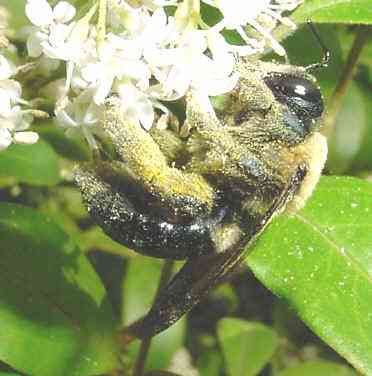|
Home
Bumblebees
Carpenter Bees
Honey Bees
Mining Bees

|

|
CARPENTER BEES |
| CARPENTER
BEES IN GENERAL |
Xylocopa
generally resemble bumble bees in size
and somewhat in color, being black,
metallic bluish or greenish black, or
purplish blue. Some males have yellowish
areas on the face. Both sexes may have
pale or yellowish pubescence on the
thorax, legs, or abdomen, but these
hairs are not as abundant or as
intensely colored as in bumble bees.
Large carpenter bees are readily
distinguished from bumble
bees primarily by the absence of
pubescence on the dorsum of the abdomen,
which is somewhat shiny. They also lack
a malar space (present in bumble bees),
and the triangular second submarginal
cell. The two species of Xylocopa
which occur in Florida are the only
species in the eastern United States,
namely X. micans Lepeletier and X.
virginica (Linnaeus).
|
| -information
provided by edis.ifas.ufl.edu |
| |
| WHERE
FOUND |
Dry,
structural coniferous woods as nesting
sites. Magnolia planks and deciduous
woods used in fence railings. X.
virginica selects nesting sites in
well-lighted areas where the wood is not
painted or covered with bark. Two
generations per year with broods in
February-March and during the summer.
Bees were active from November to
January and from April to summer.
. |
| -information
provided by edis.ifas.ufl.edu |
|
|